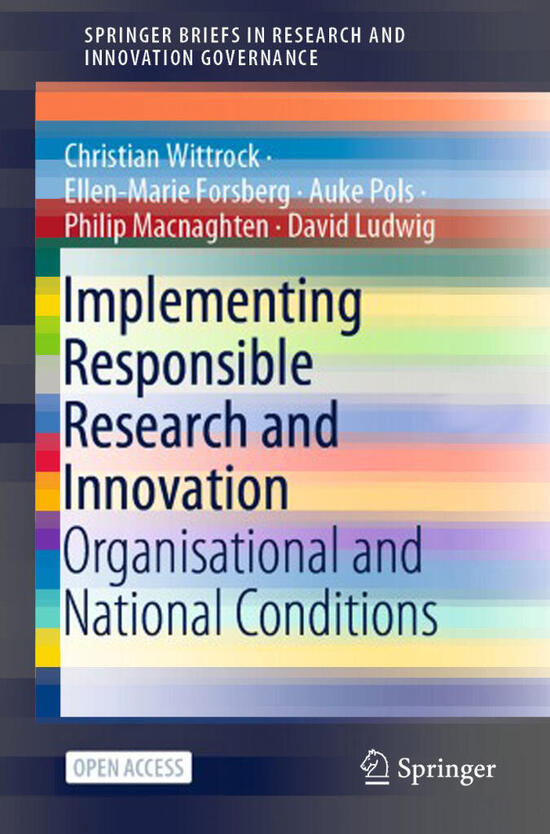Implementing Responsible Research and Innovation Organisational and National Conditions is a Springer Brief in Ethics written by Christian Wittrock, Ellen-Marie Forsberg, Auke Pols, Philip Macnaghten and David Ludwig, several of whom will be familiar names to Bassetti Foundation followers.
The book is an analysis of data collected in the EU Horizon 2020 RRI-Practice study and written in two parts, the first (written by the Norway based authors) reports on the organisational analysis in the project, while the second (written by the Waggeningen Netherlands based authors) reports on the analysis of national discourses, legal conditions and and practices studied within the project and their relationships to RRI. A third and final part ties Parts 1 and 2 together and offers reflections and thoughts on commonalities and differences in national approaches and their implications for RRI, as well as some thoughts on the international nature of research.
The book opens with an Executive summary, in which the authors summarize its aim to examine conditions for the uptake of responsible research and innovation through 5 policy keys, dedicating Part 1 to how organizational dynamics act as barriers and drivers, while exploring the formative role of national discourses and practices in Part 2. This is followed by an Abstract and the first chapter, an overview of the book and the RRI-Practice study.
Part 1: The Organisational Study of RRI Implementation
Chapter 2 introduces the authors’ understandings of RRI and the theoretical framework and methodology for the organizational study. 5 keys are cited (Ethics; Gender Equality and Diversity; Open Access and Open Science; Science Education; and Societal/Public Engagement) and four process dimensions (Anticipation and Reflexivity; Diversity and Inclusiveness; Openness and Transparency and Responsiveness and Adaptation), much of which will be familiar to Foundation readers.
After an overview of the keys and dimensions, the methodology section describes the theoretical framework used in the RRI-Practice study, derived from the neoinstitutionalist William Richard Scott and his distinctions of organizational analysis into rational, natural and open systems approaches.
An overview of the organizations studies is then followed by an explanation of the coding strategy used, with the chapter closing with a brief limitations of the study section.
Chapter 3 offers an overview of structural, cultural and interchange drivers furthering the implementation of RRI and a discussion of their influence within both research funding and research performing organizations.
The authors find structural drivers the most prevalent, with a diverse group of interchange drivers also regularly visible, while cultural drivers less seen, although all drivers interact. A discussion of their relationships with the different types of organizations follows, the chapter closing with a conclusion and reflections on drivers for RRI.
Chapter 4 is dedicated to organizational barriers for RRI and is very much structured along the lines of the previous Chapter. Structural barriers are described as plentiful (lack of resources, incentives, strategies and frameworks among a host), with cultural barriers the second largest group and interchange barriers also prominent (the role of funding organizations alongside national policies, once again with all types seen as interacting.
The chapter closes with a discussion, conclusions and reflections.
In closing Part 1 of the book, Chapter 5 presents key findings from the organizational study, considering the structure of universities, academic culture and the relationship between research performing and research funding organizations as drivers and barriers for RRI.
Part 2: Comparison of National Discourses and Practices on RRI
Chapter 6 presents an overview to part 2 in which the authors describe how they will discuss the national discourses and practices researched in the project. The introduction presents the project research question, ‘how can we understand the potential for the uptake of RRI in different national contexts?’, leading on to specification of various terms used in the question.
A methodology section follows in which the authors introduce Sheila Jassanoff’s sociotechnical imaginaries as their analytical framework, through which they will ‘examine why and how a new model on the relation between science and society, namely, the ‘RRI model’ is received differently in different national contexts’.
The chapter concludes with a brief overview of how the data used was created through the RRI-Practice project.
Chapter 7 offers overviews of each national sociotechnical imaginary as derived from this data. The summaries are concise and easy to understand, offering descriptions of policy structure and policy culture alongside other aspects of national discourses and practices.
Reports from Australia, Brazil, Bulgaria, China, France, Germany, India, Italy, The Netherlands, Norway, the UK and the USA are all analyzed and summarized, making for thought-provoking and interesting reading.
The individual reports are all available to download via the project website. I looked at the Italian report and found the Bassetti Foundation mentioned (alongside many other foundations that we work with and alongside) in relation to our involvement with the NSF funded VIRI and the Region of Lombardy Forum for Innovation, in a national context within which foundations play a leading role in influencing regional and national territorial governance and the promotion of innovation within an economic framework.
Chapter 8 is dedicated to comparison of imaginaries across countries and wider implications of the report findings, describing several implications of what they describe as salient differences with regards to policy goals, framings of the responsibilities of scientists, administrative styles and public participation goals and mechanisms.
Part 3: Conclusion
In a short conclusion the authors explain their combination of methodologies (the structural, cultural and interchange dimensions of RRI implementation in organizations drawing on neo-institutional theory in Part 1 and the national sociotechnical imaginaries of STI systems as both constraining and enabling the uptake of RRI, drawing on Science and Technology Studies in Part 2).
They then move on to addressing the influence of the research system as an international endeavour, with its shared norms and values, before briefly discussing implications of their findings for RRI practitioners.
As a Springer Brief in Ethics, this is a short and easy to read book. The authors are some of the best known (and prolific) in the field of RRI, and as an RRI-Practice project deliverable the publication (alongside the national reports) is free to download under a Creative Commons license. It is beautifully written, offers a wealth of information and experience and can be read start to finish in a few short hours.
——————

















